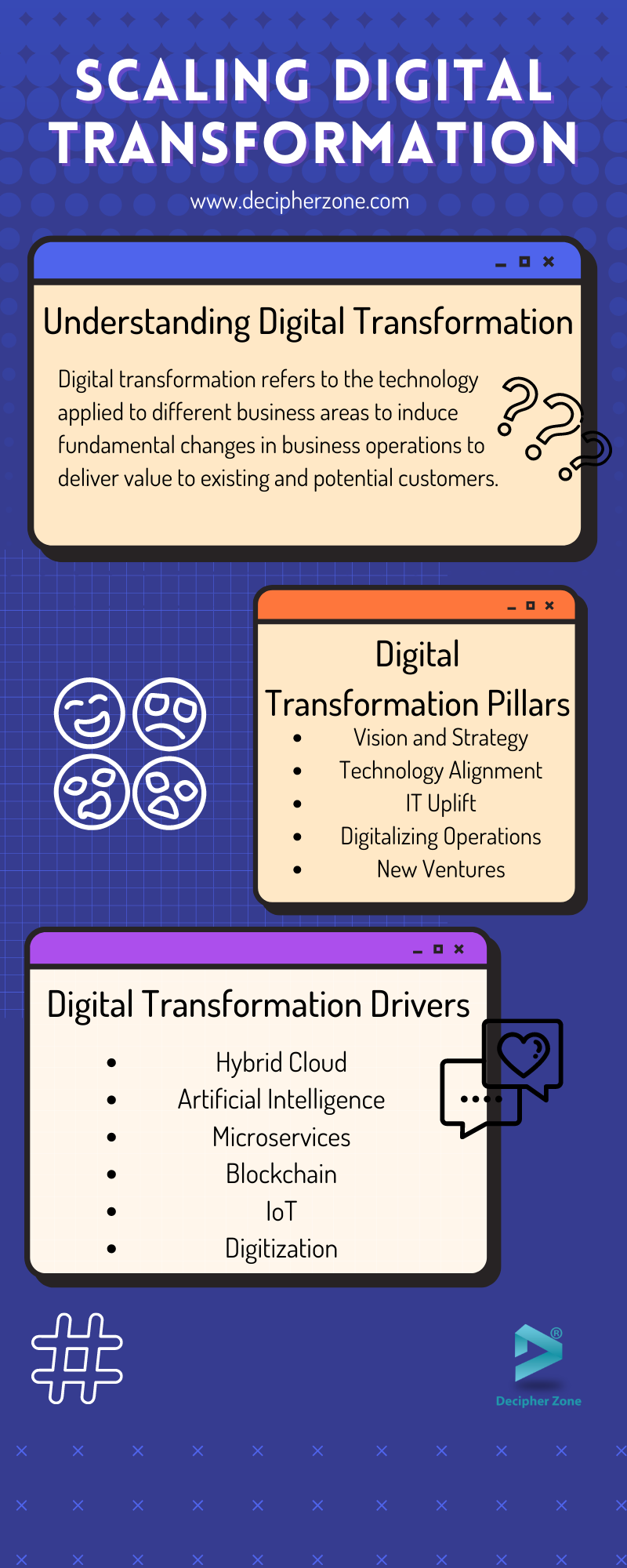How To Scale Up Digital Transformation? With continuous technology advancements, businesses prioritize digital transformation to reach their goals and attain success. Digital transformation has been helping businesses streamline their operations and internal processes.
While digital transformation can be a silver bullet for most organizations across industries, not identifying how technology can help gain a competitive advantage can cause huge losses, especially for small businesses.
So, in this blog, we will discuss everything about digital transformation and its scaling, allowing you to leverage technology in the right way.
How To Scale Up Digital Transformation?
Digital transformation refers to the technology applied to different business areas to induce fundamental changes in business operations to deliver value to existing and potential customers.
It is an intersection of technology, people, and business that can achieve remarkable results when these involved parties work in synchronization.
Read: Digital Transformation in the Healthcare Industry
Digital transformation also acts as a cultural change that encourages organizations to continuously experiment, challenge the status quo, and get comfortable with temporary setbacks.
A few things to remember while working on scaling digital transformation is that it requires clear problem statements, aspirational goals, and clear opportunities. Needless to say, digital transformation gives a possibility to reimagine the way an organization works from scratch.
Read: Data Transformation 101
Also, the most popular terms nowadays that you might have heard about, digitization and digitalization, are connected to digital transformation.
While digitization refers to the transformation of analog data and information into digital ones, digitalization refers to the use of technologies that change the processes for faster time to market.
Read: Healthcare Digitalization Trends
Moreover, digital transformation requires a shift from traditional thinking to experimental, collaborative approaches that can assist in enhancing customer experience, driving innovation, improving operational efficiency, and stimulating company growth.
Benefits of Digital Transformation
Some of the benefits that implementing digital transformation can bring to a business are -
-
Better Data Collection
-
Enhanced Customer Experience
-
Data-Driven Insights
-
Improved Collaboration and Communication
-
Increase Agility and Efficiency
The best way to ensure the success of the digital transformation of your organization is through considering product and customer experience enhancements, centralizing IT governance, protecting customer data, opting right technologies, identifying ways to improve the team’s productivity, and automating processes.
Pillars of Digital Transformation
Now that we have a better understanding of digital transformation, let’s understand the pillars that support success in transforming a business.
There are five pillars to scale digital transformation in a business, they are
Vision
One of the major challenges that companies go through while opting for digital transformation is establishing a vision. It is crucial to come up with a vision on which everyone from IT, marketing, management, and sales departments can agree.
And to do so all you need to do is create the vision and strategy along with others by analyzing global and macro trends that will impact your business, observing a day in the life of your customers, and identifying what will help you make progress.
Technology Alignment
A successful business digital transformation requires alignment of technologies you are going to implement in the customer-facing channels, manufacturing environments, and IT infrastructure.
And to achieve this alignment, new components in the organization’s software applications, APIs, Data cleanup, etc. will be required. Also, to ensure the flexibility and scalability of the web apps, the right development methodologies, programming languages, frameworks, and styles will be needed.
IT Uplift
Digital transformation for multiple organizations initiated with an upgrade in IT infrastructure. It provides a chance for companies to use the IT budget and modernize the communication and IT platforms with up-to-date tools.
This helps in minimizing IT maintenance costs while improving employee productivity, efficiency, and satisfaction.
Digitizing Operations
It is yet another essential pillar to simplify digital transformation. For digitizing operations, companies need to use digital tools and technologies such as IoT, AI, Cloud, etc. to streamline, optimize, rationalize, and simplify existing processes.
New Ventures
Digital transformation opens several opportunities for enterprises, new business models, services, and products, that they need to seize through innovating and testing new growth sources.

Drivers of Digital Transformation
Digital and virtual technologies play a central role in the digital transformation of a business. Some of the major drivers for digital transformation are:
Hybrid Cloud
It is a concept of cloud computing that combines on-premise IT resources with public/private cloud.
By not locking an organization into a single vendor/platform while creating a flexible cloud module for running workloads, hybrid clouds help organizations in improving their scalability, agility, and resilience to persist in the process of digital transformation.
Artificial Intelligence
AI technologies like machine learning allows a machine or computer to mimic the capabilities of the human mind. AI when integrated with automation inspires intelligence and real-time decisions in different operations and processes.
With AI, businesses can not only optimize their workflows but also provide personalized user experiences and come up with innovative solutions.
Microservices
It can be the engine to counter digital disruptions when aligned with DevOps or Agile development methodologies. Microservices is an application architecture that helps developers in creating loosely coupled, independent component-based applications.
Using microservices, businesses can easily deploy and release new web applications or software features without disrupting the entire software infrastructure.
Blockchain
As you might already know, blockchain technology refers to a shared, transparent, immutable digital ledger of transactions. It can help supply chain and manufacturing industries with super-resilient transformations when it comes to financial services.
IoT
Equipped with sensors that collect and transfer data using the internet. With IoT, any application like self-driving cars that generate real-time data can transfer them to Big Data analytics applications to be analyzed and used for decision-making and automation.
Digitization
It is the transformation of analog data into digital data that helps virtualize industries like education, healthcare, or government.
Conclusion
By now you must have an understanding of digital transformation, its supporting pillars, benefits, best practices, and technology drivers. We hope that this blog helped you with a clear perspective of digital transformation.
Remember for planning a successful digital transformation, you need to transform the business strategy, adopt new agility practices, realign business operations, choose flexible tech for sustainable growth, and manage changes.
And if you are wondering how to bring digital transformation into your organization, then our experienced team at Decipher Zone can help you with just that.
All you have to do is, get in touch with us and share your ideas and requirements. With some basic details from your end, we will be able to provide you with software and web app solutions to boost the digital transformation in your organization.
Frequently Asked Questions (FAQs): Digital Transformation
What is digital transformation, and why is it important?
Digital transformation refers to the technology applied to different business areas to induce fundamental changes in business operations to deliver value to existing and potential customers. It helps enhance customer experience, drive innovation, improve operational efficiency, and stimulate company growth.
What are the key pillars of digital transformation?
Vision, Technology Alignment, IT Uplify, Digitizing Operations, and New Ventures are the key digital transformation pillars.
What are the benefits of digital transformation?
Better Data Collection, Enhanced Customer Experience, Data-Driven Insights, Improved Collaboration and Communication, and Increased Agility and Efficiency are the primary benefits that digital transformation brings to the organization.

